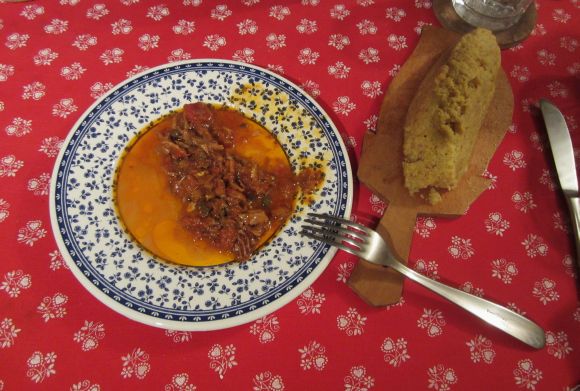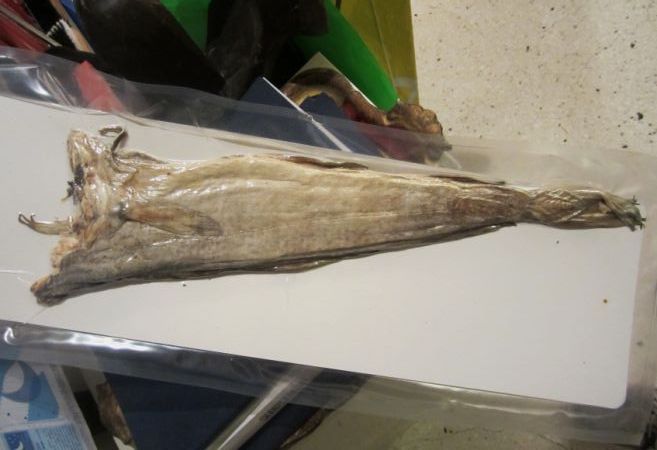
There is an old 19th-century song from Istria (the peninsula just below Trieste, which used to belong to Venice) entitled “La Mula de Parenzo.” Parenzo was the Italian name for a coastal town now known as Porec, Croatia. “Mula” is the traditional local word for a woman from Trieste, or thereabout. Yes, it means a feminine mule. Just go with it.
Now that I’ve set the stage, let’s get to the song. And the food.
I love this song, partly because it’s so jaunty, and partly because it’s the only local song I’ve learned all the way through. I’m very proud of that, considering that it has five verses, though the repetition of each phrase helps. I’ve never tried to get past the first verse of the national anthem, but I don’t think anybody has. It’s also got five verses, but they’re patriotic poetry with exotic references, which is harder to retain.
Here’s how it starts (I translate): “The mula of Parenzo/set up a shop/she sold everything/except baccala’/because (or why — same word) you don’t love me anymore.” And continues, “If the seas were sauce/and the mountains polenta/oh mamma, what soaking-up-the-sauce-with-pieces-of-polenta there would be (“che tociae“)/Polenta and baccala’/because (why) you don’t love me anymore.”
Significance quotient: zero. Musical wordage value: 100.
Here is the link, for those who do not see the clip itself here: http://youtu.be/MOWFC-tL9Ss
Polenta seems to be a useful placeholder word, at least in some old-fashioned spontaneous sayings. I’ve sometimes heard Lino say (partly joking) this elderly Venetian phrase which expresses general wonderment: “Ooooh, verze del mio ben, poenta e tocio.” (“Oh, cabbage of my beloved, polenta and sauce.”) No, it doesn’t mean anything, but it shows how useful a word polenta can be. Not to mention the food itself.
“Tocio” (TOE-cho) is Venetian for sauce (in Italian, sugo). The verb: tociar (to-CHAR). I think it must have been remodeled from “toccare,” Italian for “touch.” So therefore, working backwards, the sauce is defined as the thing that gets touched — by bread, by polenta, etc.
As for baccala’, you might be interested to know that the word in fact refers to cod that has been preserved by salting. Stockfish, or stoccafisso, is cod which has been air-dried, preferably in the bracing air of northern Norway. So the fact that Venetians call stockfish baccala’ just goes to show something. Perhaps it’s another example of their “we do things our own way” approach to life, the world, themselves, and also to fish.
Here is the fundamental thing to know about preparing stoccafisso: You have to soak it for at least three days and nights, changing the water every six hours. That in itself is not so demanding, though it does represent a commitment to this dish.
What’s really demanding is the smell. I’m not going to tell you what it’s like, although I could, because I don’t want to discourage you. Unlike andouillette, however, the odor does not presage the flavor. I don’t believe the fish was born smelling like that, so evidently drying its carcass north of the Arctic Circle inflicts some infernal change on its molecules.
Eventually the water carries away whatever effect the drying process has wrought upon this innocent fish. And the remaining flavor is worth waiting days for.
Apologies to anyone who thinks they could say the same thing about andouillete, especially my friend Michel in Nantes, who may be reading this. But they are wrong.

BACCALA’ IN TECIA (TEH-cha). Many other classic recipes for baccala’ (stoccafisso, I mean) don’t include tomatoes, but this is the humblest Venetian version and it will never betray you.
So you soak it for days. When it has become softer and moister, you remove it from the pan, and send the water to the toxic waste disposal site.
Take the fish and open it like a book, remove the central bone and assorted remaining bones, and break the fish into pieces with your hands.
Chop some onions, and saute them in some olive oil.
Add the fish, and stir.
Add peeled chopped tomatoes (we use the canned sort; if you’re a purist, feel free to use fresh tomatoes but I can’t predict the outcome).
Add a few sardines preserved in salt, which you have thoroughly rinsed.
Add a handful of capers preserved in salt, which you also have rinsed. If you use capers preserved in vinegar I decline any responsibility for the result, because they taste like they’ve been kept in a laboratory somewhere, in formaldehyde.
Salt and pepper, to taste. Do not point out the humor in the idea of having removed salt from the sardines and capers only to replace it from a box. I see it all by myself.
Simmer till the sauce is reduced and the flavor is harmonious. Don’t simmer it thinking that the fish will become more tender; it will always be chewy.
As for polenta, I won’t be there to check on you, but you should know that Lino makes the traditional variety, which requires stirring for about 40 minutes. I think the result is worth the effort, but then again, he’s the one doing the stirring.
And it has to be yellow polenta, not white. Venetians eat yellow polenta; white is favored by outliers from Pellestrina and Burano.

Trivia Alert: According to the Norwegian Fishing Village Museum, “There are 30 countries on the list of buyers of this exalted commodity. At the top of the list, Italy prevails unchallenged, importing 3946 tons. It is therefore not without good reason that the Mayor of Røst says, “God bless Italian housewives and their kitchens! Long live Italian cuisine!” And God bless one Italian man, too, who actually likes changing the water every six hours and stirring the polenta into total submission.

9 Comments
I love this song! And I was surprised to realise I actually know this one, my Zia and Nonna used to play this on their battered cassette tapes. I’m also sure everyone used to burst into song at festas. I never knew what this was about – good to know. I just thought it was of someone losing their love!
I’ve never been tempted to eat baccala’ but perhaps I will now with this recipe. I’ll have to see if I can get it in the UK.
I love polenta like this with sepia in umido – one of my favourite dishes.
Thanks for the great post.
I’m happy to know that this brought back memories, even from across the sea/generations. I’d be very surprised if you couldn’t find it; there are plenty of baccala’-eating folks in the UK by now, and not just Italians. Caribbean and African people eat it too. I just checked: If all else fails, you can order stockfish through Amazon.
Baccala is a staple of Portugese and Spanish cooking. I don’t know what the etymology is the Venetians are in tune with a larger world. I can vouch for the flavour when properly prepared. I eat it whenever I can, but I’ve never actually cooked it.
Well, now you have a project for those gloomy winter days. Instead of sitting and looking out the window at the gray clouds, you could be changing baccala’ water. I bet you never thought you could ever eat it in your very own home, but now you know that you can. There are scores of recipes — it won’t count against you if you decide to go with somebody else’s version. It’s always going to be good. As you know.
Oh I love this stuff. Being a ‘mula’ from Trieste, I grew up with both the dish and the song (when my parents used to sing it with their friends here in Australia). Some folks find baccala too ‘fishy’ but that’s its beauty. And the polenta goes perfectly with it. I also like it shaped and fried as cod balls – very Portuguese I believe!
I love that Venetian phrase! May I ask you for the correct pronunciation of the words please, so that I may use it to the utter bafflement of everyone around me?
Well yes, but a great deal depends on the intonation of the whole phrase. It starts on a high note (you decide how high — I don’t mean a screech) and then gently swoops down the words, losing energy along the way, to a sort of middle note. Having said that, I can hope for the best. “VEHR-zeh del mio ben, po-EN-ta e TOE-cho.”
Polenta and baccala is loved by the Garfagnini, and their descendants all over the world.
In Australia amongst Italian descendants Polenta has become a stable at BBQ’s , where its grilled and eaten with cheese. In fact sometimes the meat is forgotten or overlooked and every one waits/demands the polenta.
Polenta is often eaten with cheese in the mountains north of Venice (homeland of great cheese). But to hear that Australians would overlook meat in favor of anything is shocking. But then again, my parents were from Tennessee, so I grew up eating cornbread and, occasionally, hoecake. So I already am attuned to the lure of the cornmeal, especially when it’s crusty. Excuse me, I have to go eat something now, this is making me hungry.